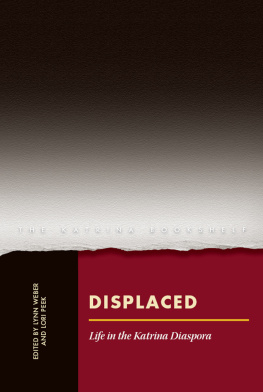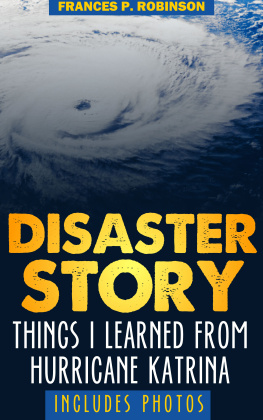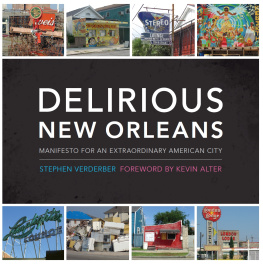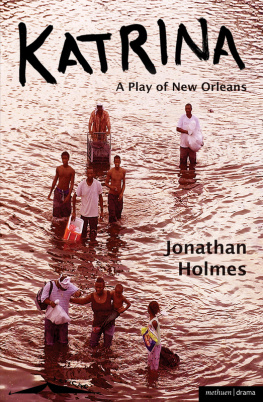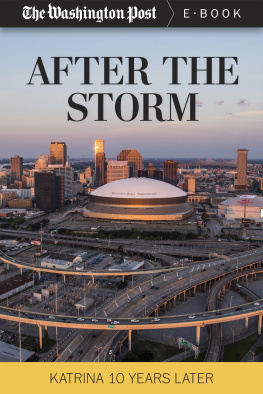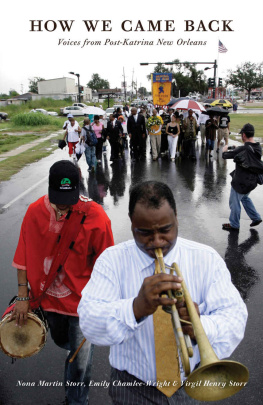THE KATRINA BOOKSHELF
Kai Erikson, Series Editor
In 2005 Hurricane Katrina crashed into the Gulf Coast and precipitated the flooding of New Orleans. It was a towering catastrophe by any standard. Some 1,800 persons were killed outright. More than a million were forced to relocate, many for the remainder of their lives. A city of five hundred thousand was nearly emptied of life. The storm stripped away the surface of our social structure and showed us what lies beneatha grim picture of race, class, and gender in these United States.
It is crucial to get this story straight so that we may learn from it and be ready for that stark inevitability, the next time. When seen through a social science lens, Katrina informs us of the real human costs of a disaster and helps prepare us for the events that we know are lurking just over the horizon. The Katrina Bookshelf is the result of a national effort to bring experts together in a collaborative program of research on the human costs of the disaster. The program was supported by the Ford, Gates, MacArthur, Rockefeller, and Russell Sage Foundations and sponsored by the Social Science Research Council. This is the most comprehensive social science coverage of a disaster to be found anywhere in the literature. It is also a deeply human story.
LEFT TO CHANCE
HURRICANE KATRINA AND THE STORY OF TWO NEW ORLEANS NEIGHBORHOODS
STEVE KROLL-SMITH, VERN BAXTER, AND PAM JENKINS

University of Texas Press
AUSTIN
Copyright 2015 by the University of Texas Press
All rights reserved
First edition, 2015
Requests for permission to reproduce material from this work should be sent to:
Permissions
University of Texas Press
P.O. Box 7819
Austin, TX 78713-7819
http://utpress.utexas.edu/index.php/rp-form
LIBRARY OF CONGRESS CATALOGING-IN-PUBLICATION DATA
Kroll-Smith, Steve, 1947 author.
Left to chance : Hurricane Katrina and the story of two New Orleans neighborhoods / Steve Kroll-Smith, Vern Baxter, and Pam Jenkins. First edition.
pages cm
Includes bibliographical references and index.
ISBN 978-1-4773-0369-6 (cloth)
ISBN 978-1-4773-0384-9 (pbk.)
ISBN 9781477303856 (non-lib. ebook)
ISBN 978-1-4773-0385-6 (ebook)
1. Hurricane Katrina, 2005. 2. Disaster victimsLouisianaNew Orleans. 3. RacismUnited States. 4. United StatesRace relations. 5. Social classesLouisianaNew Orleans. 6. NeighborhoodsLouisianaNew Orleans. I. Baxter, Vern K., author. II. Jenkins, Pamela, author. III. Title.
HV6362005.N4 K76 2015
976.3'35064dc23 2014036203
doi: 10.7560/303696
Dedication
To all who struggled to remake their lives in the wake of
this historic flood, we owe you our deepest gratitude; youve
earned our deepest respect. And to Amanda, who left us
far too soon, be assured darlin, your spirit continues.
CONTENTS
by Elijah Anderson
ACKNOWLEDGMENTS
In the seemingly endless path between beginning to research and write this book and finishing what we started, many people appear and in their own ways lend a hand.
Steve took inspiration from Susan, Emma, Brett, Leo, and Betty Lu. Thank you.
Among those who made significant contributions are Kai Erikson and Carol Stack. Two former graduate students and now junior faculty at the University of North Carolina, Greensboro, also provided important help along the way: Amy Ernstes and Tina Spach. We want to thank Kevin Brown, executive director of Trinity Christian Community Center; the Reverend Earl Williams; and Howard Rodgers, executive director of Orleans Parish Council on Aging. Lori Peek, Art Murphy, and Pete Kellett commented on various drafts and proposed book titles along the way. Our thanks to each of you.
And each of us found tenacity and wisdom in the many conversations we had with various people throughout this research. Among them are Cheryl Hayes, Bo Green, Jolinda Johnson, Diane Wooden, Denise Ancar, Pearly and Janet Harris, Jessie Green, Alayna Miller, and Michael Carey. And finally, we want to thank the Bill and Melinda Gates Foundation for providing the initial funding that got this project off the ground.
FOREWORD
Hurricane Katrina struck New Orleans at the beginning of the twenty-first century. Her winds and waters stirred up the history of this fabled city. Disasters generally have a way of making the past present, and this one was no exception. It did not take long to see that Katrina and the flooding of the city threw New Orleans ugly race history into sharp relief.
During antebellum times being sold down the river, namely, the Mississippi River, was a source of profound worry for blacks. New Orleans, the end point down the river, was imagined to be a city of sorrows. It was an abyss, a den of wickedness; it was thought to be the worst place a person could be sent. The horror of being sold down the river is a theme sounded in literature and oral tradition. In Uncle Toms Cabin, the eponymous character meets his death at the run-down plantation of Simon Legree, down the river in rural Louisiana.
It is worth recalling that by 1840 New Orleans was the center of the slave trade in the United States. In his autobiography, Twelve Years a Slave, Solomon Northup recounts a slave auction in the Vieux Carr. In vivid prose he describes this dehumanizing momentthe slave pens, the wrenching apart of families, the horror of it all. Summoning words from somewhere within, Northup concludes his account with this telling afterthought: It was a mournful scene indeed.
It was a mournful scene indeed is a string of words that spans the wretched misery of the nineteenth-century slave auction and that catastrophic moment more than 160 years later when tens of thousands of black families lost everything, some even life itself. White people living in New Orleans also suffered, of course. But they could weather their misery in the absence of that ornery consciousness described by W.E.B. Du Bois as the double: one ever feels his two-ness, an American, a Negro; two souls... two unreconciled strivings; two warring ideals.
As Katrina made its way to New Orleans, Mayor Ray Nagin issued the first mandatory order to evacuate in the history of the city. It is worth setting the demographic and temporal context for the mayors order. When Katrina slammed into the eastern edge of the Paris of the South, more than half of the population of New Orleans was black. Moreover, New Orleans ranked eighth among American cities with the poorest populations. Twenty-eight percent lived below the poverty line. Fourteen percent of city residents lived
Now, consider the date that the mayor issued his evacuation order: August 28, the end of the month. For folks living below, at, or just above the poverty line, money was in short supply in the last few days of August. Who could afford to evacuate became a question rooted in the history of the city. The best many people could do was seek refuge on their roofs. Many stayed there for days. Some didnt make it, perishing from the punishing heat and lack of food and water. In many ways Hurricane Katrina was a perfect storm throwing into stark relief the consequences of long years of racial oppression, a mutating economy, and, as this book documents, a failed federal relief effort.
Left to Chance steps boldly into this fray. The authors look closely and over a long period at the experiences of residents in two historic New Orleans neighborhoods, both African American: Hollygrove and Pontchartrain Park. The first is a working-class enclave reclaimed from swamp sometime in the 1920s. Subject to the whims of city planners, major thoroughfares slice through this neighborhood, giving it a haphazard look and feel, as if what is there is simply what is left after others make decisions about how best to travel by car.


